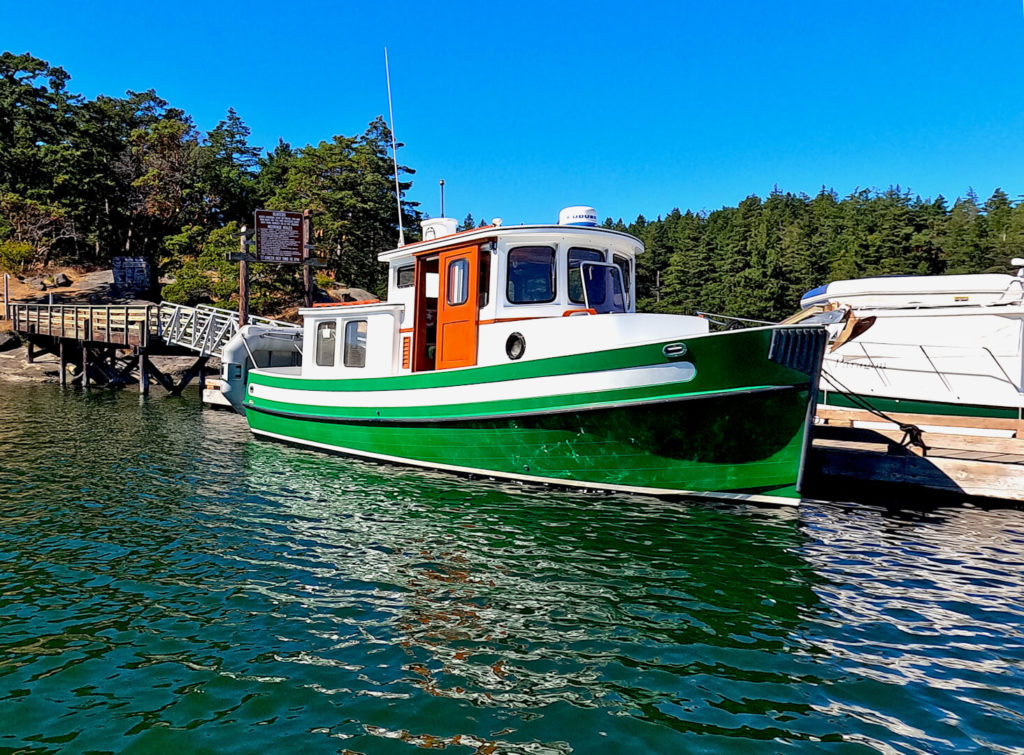
What kind of boat is the Nordic Tug 26? Is it a yacht? A tugboat? A trawler? At only 26 feet, how could it be any of those? In many ways it defies convention. It has a full keel trawler hull, but with enough power, it can exceed traditional trawler speeds. It is fully equipped for multi-day cruising with complete plumbing, electrical, and heating systems like a yacht. Yet at 26 feet, it fits on a trailer that can be towed behind a 3/4 ton pickup.
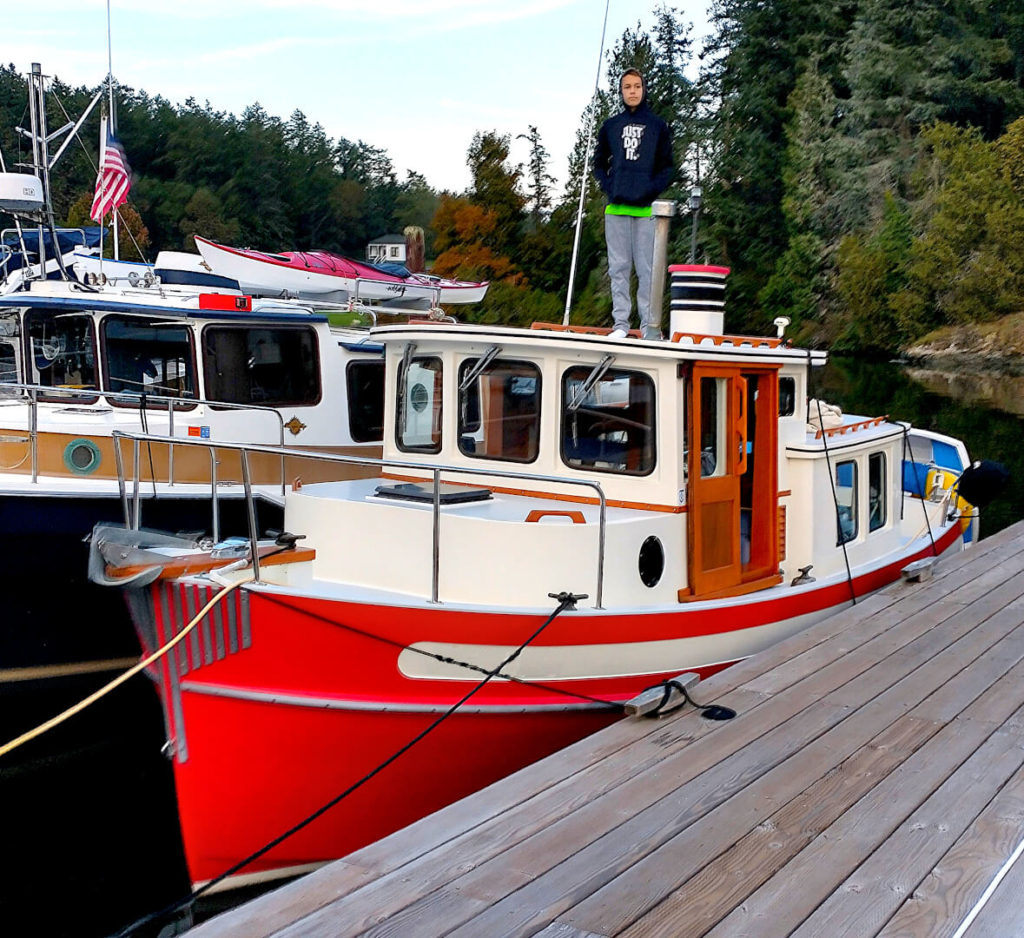
For our review, we chartered a 1983 Nordic Tug 26, for a two-day weekend in the Pacific Northwest to see if the boat performed as good as it looked.
Pros
- Comfortable, quiet, spacious pilothouse
- Timeless beauty makes it one of the most well-loved boats on the water
- Generous space for overnight cruising with 2 adults and 1-2 kids
- Full suite of yacht systems
Cons
- Not as surefooted in heavy weather as I expected
- Headroom: Rachel and I both banged our heads in the stairway constantly
- Hull is less efficient than a sailboat and slower than a planing hull powerboat
At the Helm of the Nordic Tug 26
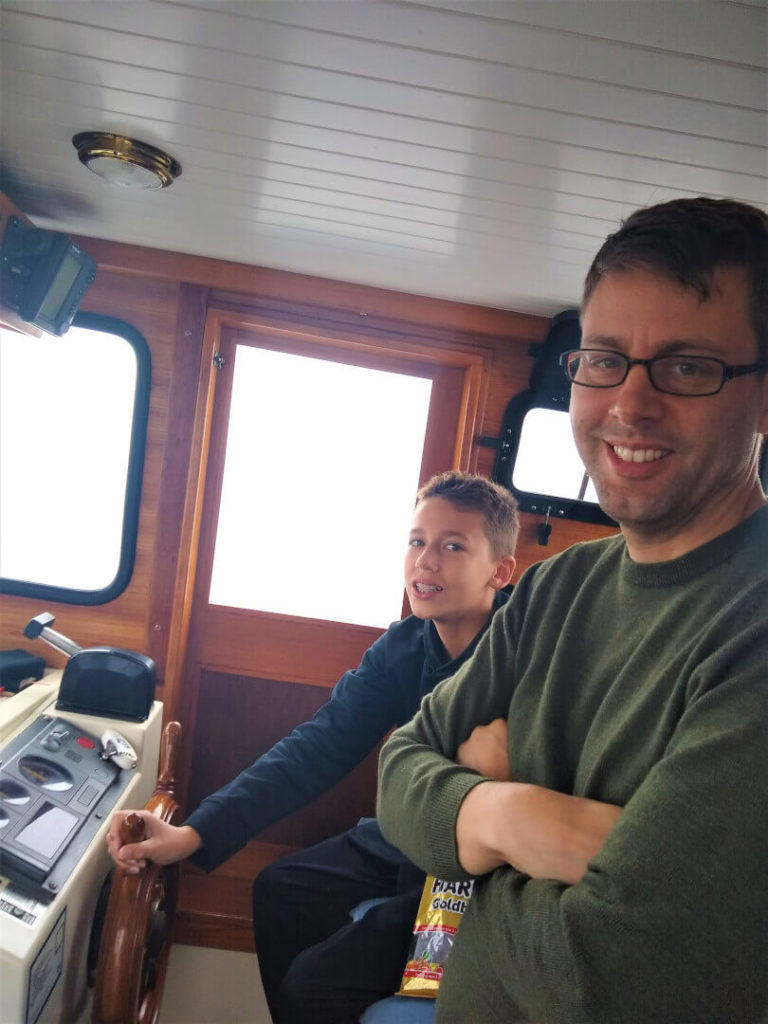
The pilothouse on this boat may be its best attribute. It has plenty of room for a six-footer like me to stand up comfortably, seating for three adults, and very clear, near 360-degree visibility. Rear-facing windows on either side of the pilothouse allow for a quick check behind you to look for approaching ferries and to make sure you aren’t turning into an oncoming boat. Larger pilothouses with flybridges above aren’t able to accommodate this. They require you to duck under the salon roof to see straight back, or stick your head out the pilothouse doors to get this view.
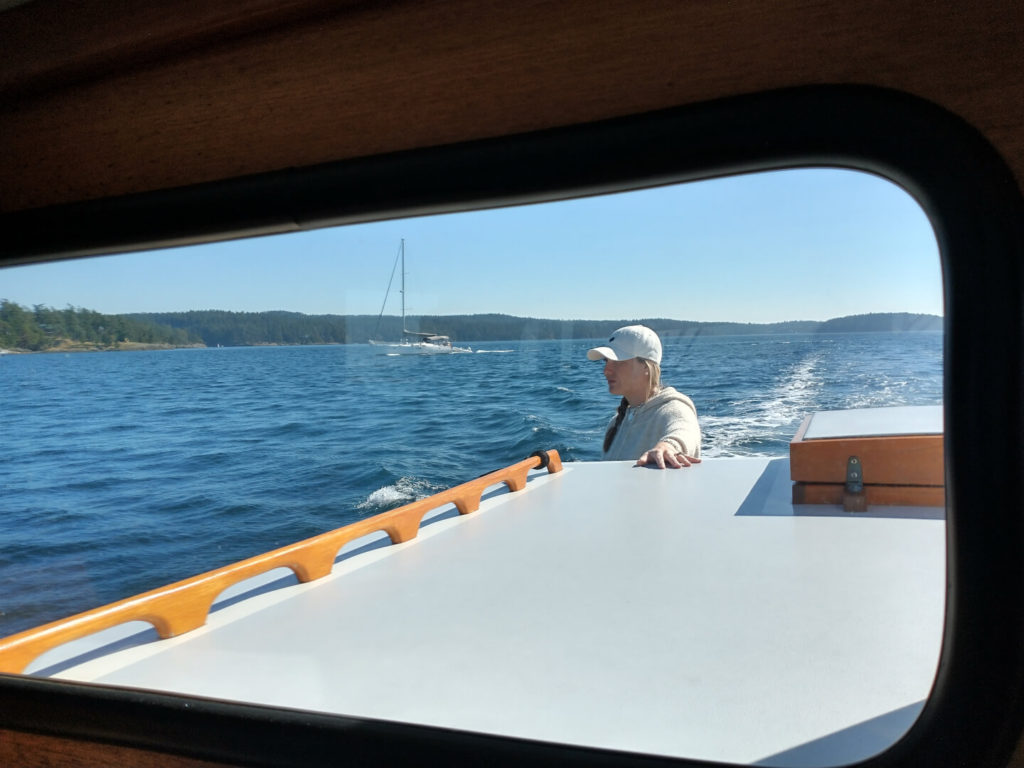
The wooden ships wheel had handles that extend beyond the rim. This looked very “nautical” and “vintage”, but now I know why they aren’t common today. They are difficult to turn quickly while docking, especially without looking, because the handles get in the way of grabbing the wheel.
The pilothouse has sliding doors on both sides to allow easy access to the bow for docking, mooring, or anchoring. They’re also great for letting in a ton of fresh air, and allow you to poke your head out for a better view when docking or checking your six.
There is a bench on each both side of the pilothouse. The starboard (right) side in front of the helm has a wider seat with plenty of room for two. I love this configuration when cruising because you can snuggle up to your boo and/or make room for a lookout to share the controls. The seats have a folding bolster that you can leave down to make room to stand and walk to the doors, or lift up to for a more comfortable bench to sit on. The controls are mounted a bit high so you can comfortably control the boat from a sitting or standing position while the seat serves as a leaning post. Being able to both sit and stand helps with fatigue as you can change positions from time to time while under way.
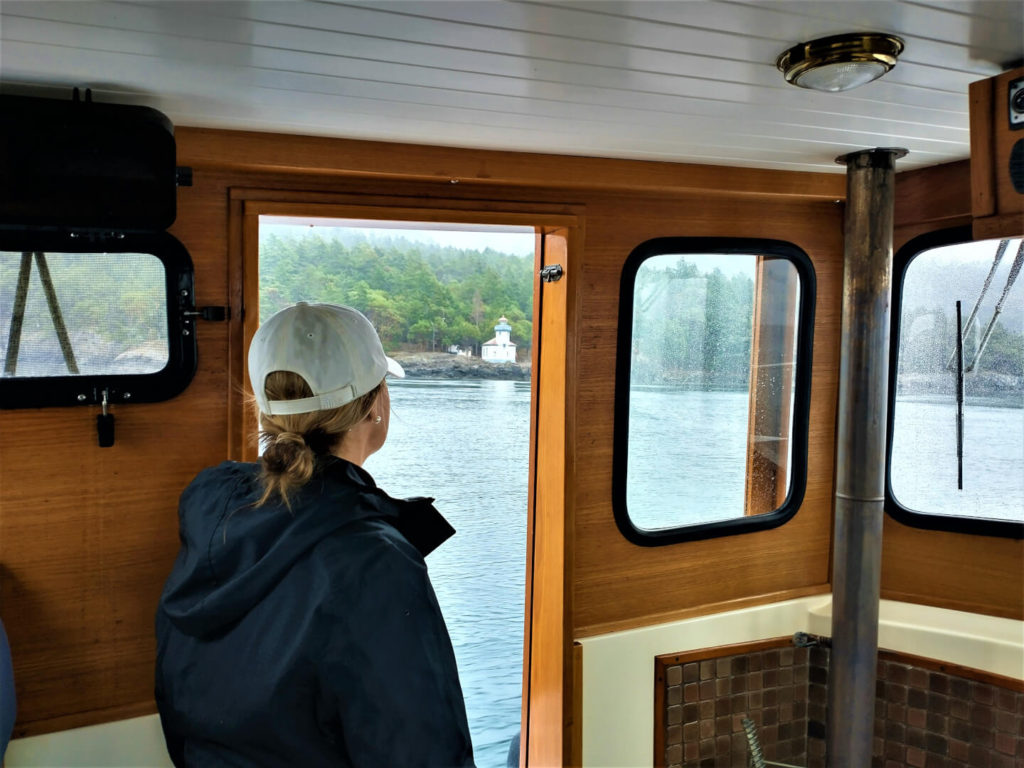
Our test boat had a rare feature in the pilothouse: a small wood stove. Most Nordic Tug 26’s have a small cabinet here. So, there was less room for charts, phones, and binoculars on the dash, and this took away from the storage underneath. Before our cruise, I also wondered about the safety and effectiveness of the stove. However, the stove was quite small, low, and out of the way with a footrest in front to help the crew stay clear. It didn’t get cold enough to use the stove on our trip, but, given that the entire cabin heated up when we boiled a pot of coffee (with the pilothouse door open no less). I’d now be concerned about getting overheated with a larger wood stove.
Engine
The Nordic 26 has been equipped with a variety of diesel engines over the years. Ranging from about 50 to 150 horsepower. Our boat was equipped with a 100 horsepower Yanmar that was retrofitted in the 90’s. You’ll see early boats tend to have lower horsepower than newer boats. I don’t know if this is because it took time to discover the potential of the Nordic Tug 26 hull to plane, or if turbocharging and intercooling was needed to design higher output engines that could fit under the pilothouse.
I was worried that the boat would be noisy with the engine mounted directly under the pilothouse floor. This was not the case at all. Under way, at 2,600 RPMs, the engine made a very calm, harmonious “clack clack clack” beneath the floor. It was much quieter than the cockpit of many diesel sailboats, free from buzzing, rattles, and white noise.
We cruised at 2,500-2,600 RPMs, making about 7.5 knots while burning about 2 gallons of diesel per hour. The Yanmar 100 horsepower engine produces about 60 horsepower at this speed, according to factory output curves (so it can certainly go faster). The 75-gallon fuel tank provides a theoretical range of 240 miles at this speed. Reducing speed to 6 knots would likely increase range and efficiency significantly because the boat would be running below the hull speed and not wasting energy to climb out of the water.
The boat length is 25 feet at the water line, giving it a theoretical hull speed of 6.5 knots. The remarkably large rolling wake behind us was another indicator that we were planing at 7.5 knots. So, the hull definitely has some ability to get on a plane and exceed this theoretical limit. Despite the observed commotion behind us, the boat pushed forward with confidence at all engine speeds without the ‘getting up on a plane’ event that causes the bow to rise uncomfortably on faster boats. As far as speed goes, this 100hp Yanmar can likely get her up to 10 knots with more throttle if you need to get home fast or get more control in rough waters.
Under Way
As discussed earlier, we hummed quietly and calmly at about 7.5 knots. I credit the lack of noise, vibration, and harshness to the larger, well-balanced motor as well as the well-insulated pilothouse floor. Our boat was carpeted, while some have wood floors. Wood looks great and is easier to keep clean and dry, but carpet goes a long way in damping the engine noise.
The boat did not have a means to measure fuel burn while under way as it was repowered before electronic controls were common. It also lacks a fuel gauge at the helm and water speed indicator. Depending on fuel gauges for an accurate reading can disappoint (or leave you stranded), and the GPS gives you speed over ground, so none of the above was much of an issue. However, I would have been grateful for a rudder position indicator. The wheel turns four times from lock to lock, so its easy to get lost on your rudder position when docking.
Steering the Nordic Tug 26
Turning a trawler at the dock is not as easy as many other boat types. The steering issues aren’t defects in the Nordic Tug 26 design, but inherent in the design traits of trawlers in general.
Prop Walk
Despite having a large rudder, the trawler is surprisingly challenging to turn at slow speeds. The issue at play here is prop walk. Prop walk is caused by the propeller being mounted on an angled shaft underneath the hull, which causes the stern (back) of the boat to rotate to one side at slow speeds, regardless of the rudder direction. Without getting into the minutiae, this is less of an issue, or not an issue at all on outdrives, outboards, twin engines, and sailboats. It is, however, also common in ski boats with direct drive and v-drive layouts.
The direction of prop walk depends on the direction of the prop rotation. On our boat, putting the boat in gear from a standstill will cause the boat’s stern to pivot to port (left) almost like a stern thruster. You simply cannot move the stern to starboard under power at low speeds. Instead, you either have to get some momentum and turn the boat while it is in neutral or turn the boat 180 degrees and approach or depart the dock from the other side. Once you get used to it, you can use this ‘feature’ to your advantage and turn the boat in very tight spaces.
Under Way
With a full keel and large rudder, you would think the boat would track straight. However, it gets pushed around by the wind, current, and waves much more than a sailboat. Sailboats have a much larger keel and less windage without the huge pilothouse sticking out of the water. At similar speeds, a powerboat with a planing hull would get pushed around even more than the Nordic Tug 26, but powerboats have more ability to get up on a plane and use forward momentum to overcome the forces of wind and current. So piloting the Nordic Tug 26 in rough seas is more of a chore than many other boats this size, but the autopilot helps maintain course. Additionally, the warm pilothouse is a much more ideal place to deal with this challenge than the more confident, but exposed helm of a sailboat.
Electronics
With production spanning almost 40 years now, you’ll find any manner of electronics packages in these boats. Our boat was sufficiently equipped with VHF, autohelm, two chart plotters, fishfinder, and CD player with auxiliary input for your phone. The package was somewhat dated, but completely effective.
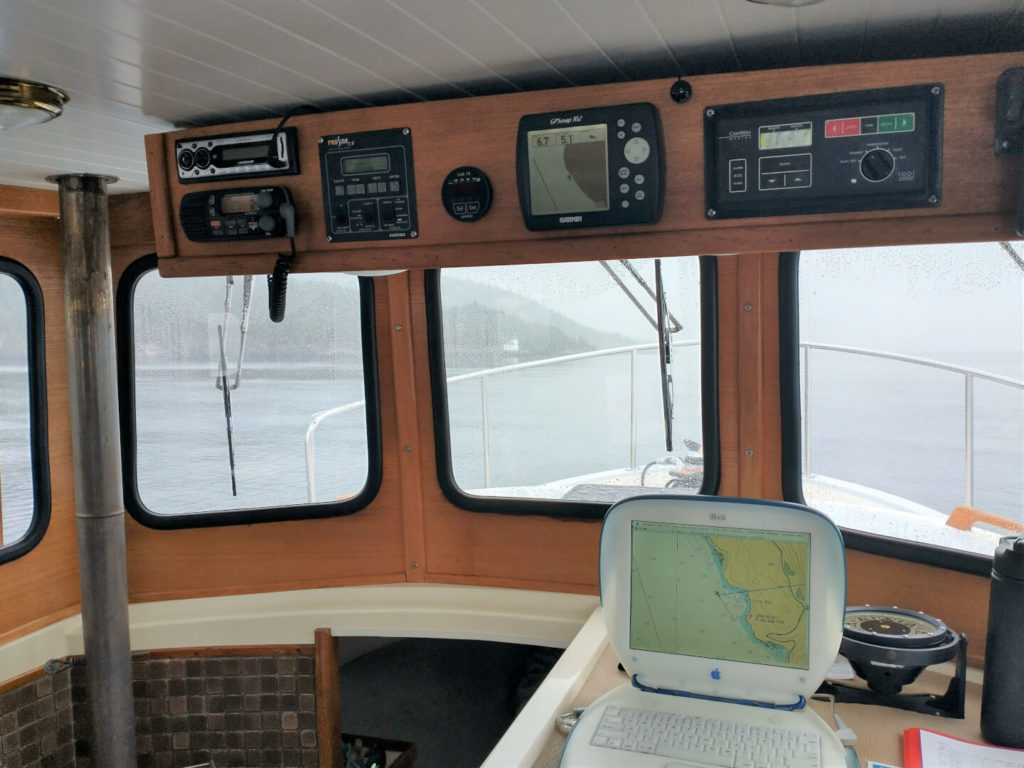
Nordic Tug 26 Living Space
It’s important to note that I’m 6-feet tall and felt confident standing straight without being crowded by the ceiling throughout the boat. However, the stairway down from the pilothouse as well as the three doorways all require some ducking. Rachel and I both banged our heads more than once coming down from the pilothouse.
Galley
The galley (kitchen) is in-line against the port (left) side of the salon behind the pilothouse. Our boat had a 12 volt-refrigerator, propane oven and stove, and sink with pressurized water. You’ll see different equipment on other boats, but this is a common layout. The oven is the most commonly omitted item and would make more room for storage beneath the stove. There’s also a propane grill mounted on the stern rail in the cockpit. The grill is a very welcome addition to keep the cabin cool on hot summer days.
I recently discovered first-hand the dangers posed by the fact that propane is heavier than air and will settle in a cabinet to explode later. However, I was very fortunate that it didn’t happen on a boat. Our boat was equipped with a propane gas detector to alert you to potential leaks before and while operating the propane system to reduce this risk.
The refrigerator was a relatively small front loader, but adequate for a crew of 2-3 for a few days. The galley had ample cabinets and drawers. However, a hungry group on a 7-day trip would have to be very deliberate to make the journey without reprovisioning.
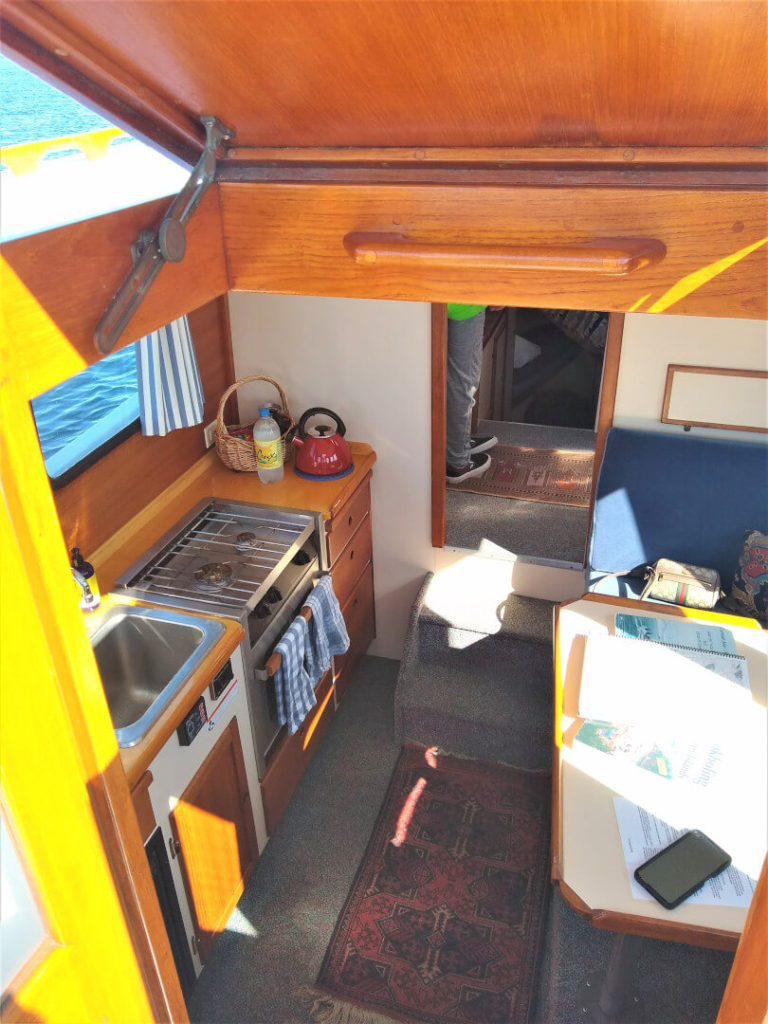
Sleeping Acommodations
All Nordic Tug 26s have one bed in the bow. Some have a V-Berth that runs the full beam (width) of the boat, and others are configured like our test boat with a berth to starboard (right) set relatively high, with a lower bench to port (left). We liked the bench to port configuration because it was a good spot to sit and tie your shoes, as well as set linens and clothing while changing. Setting the bed this high does put you in a relatively claustrophobic feeling space against the deck above. As you can see below, the outboard sleeper will experience this more than one laying toward the centerline.
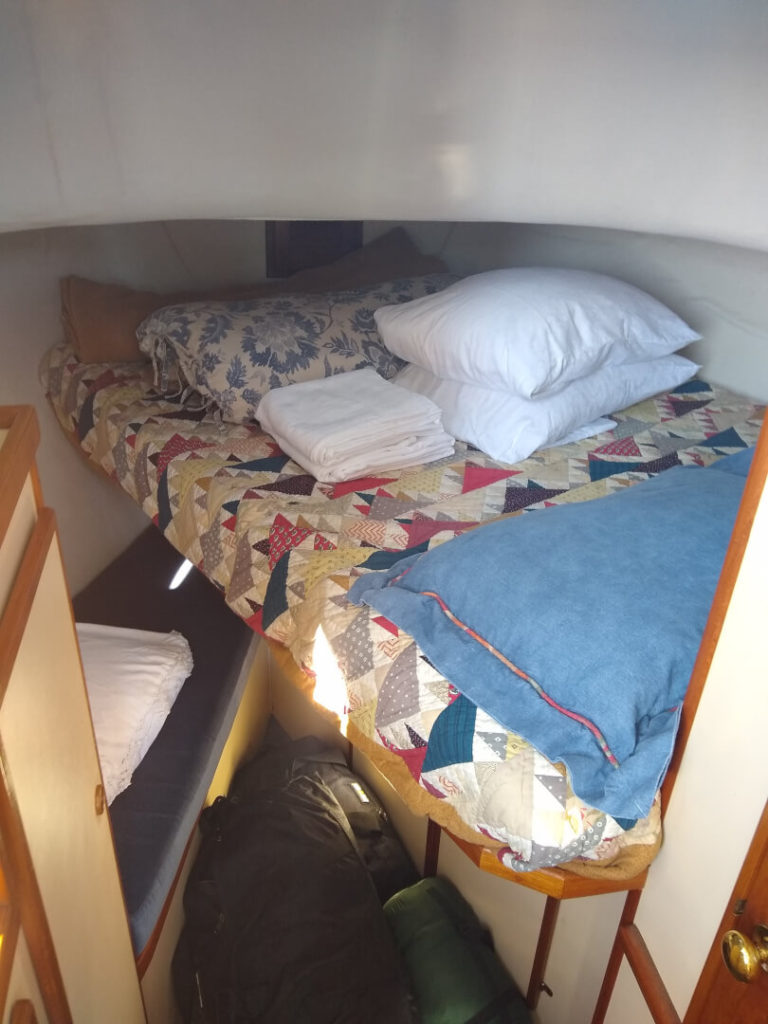
The table in the salon has a second set of support poles that allow it to be lowered and convert the bench into a bed. Removing the back cushion on the L-shaped settee (bench) on our boat revealed that the bottom cushion extended beyond the windows to the outer hull. This extra space was a convenient place to stow pillows and sleeping bags and created a few extra inches of sleeping width. George was comfortable sleeping on the bench without lowering the table. Note that some older Nordic Tug 26s and all of the newer ones are equipped with a picnic table layout that will require you to adjust the table to make enough room for sleeping.
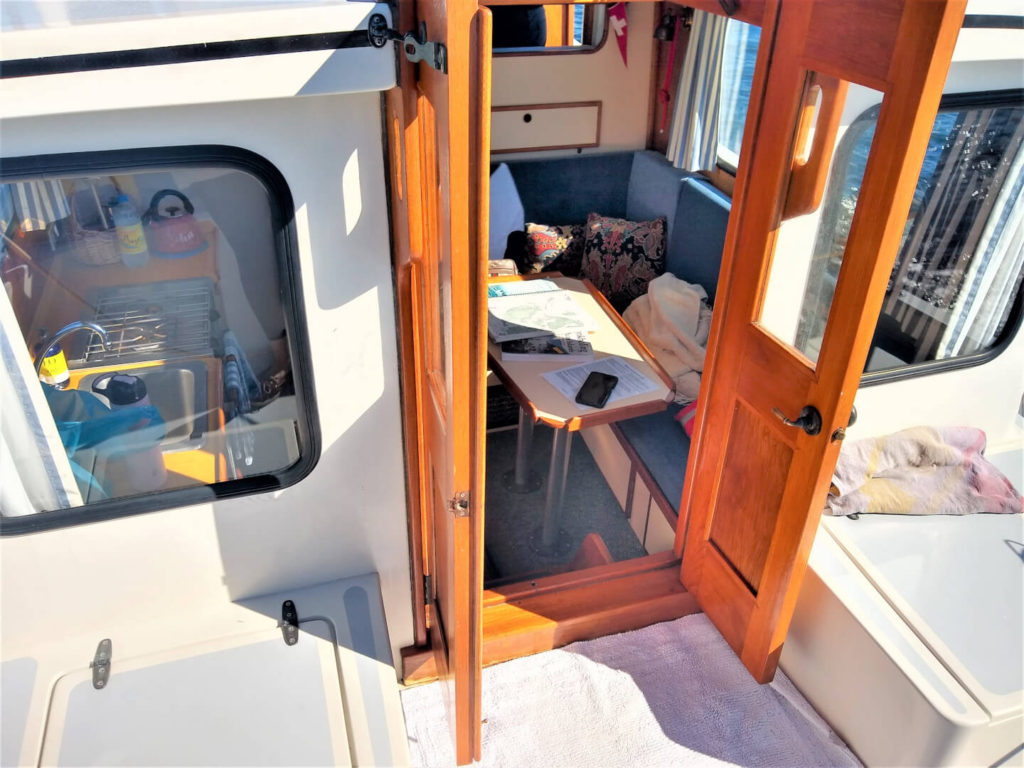
Storage
There is an incredible amount of storage on this boat considering its size. There is storage under each of the steps to the cockpit, between the settee (bench) back and the outer hull, under the settee, under the cockpit benches, in the lazarette (below the cockpit), and under the bed. There’s a nice hanging locker next to the bed for storing clothing. Under the pilothouse benches, there are shelves that can be accessed from behind the bench and from the side, which makes the area more accessible and organized than it would be if it were just a lifting bench. Our boat also had a set of hooks next to the rear door for hanging life jackets…this was not only handy, but a good place to dry them out before stuffing them into a bin.
Head (Bathroom)
Our boat was equipped with a hand pump toilet and pressurized sink. Hand pump toilets aren’t as straight forward as the tank flusher you have at home. The owner will show you how to use it during your briefing. Pay close attention to the instructions, and help young children prep and flush the toilet to keep things flowing.
This particular toilet had a very welcome upgrade: the Electrosan waste treatment system. This system macerates and sanitizes your poo before sending it safely into the great blue yonder, never to be experienced again. More commonly boats this size will have a cartridge toilet or a holding tank. Either of which require you to have a reunion with your crew’s ‘waste’ when you return to the dock.
Some Nordic Tug 26s have a drain in the floor and a detachable sink faucet for a quick shower. Unfortunately, ours did not.
Mechanical
Our boat was incredibly well equipped with a full suite of yacht systems despite its diminutive size.
Electrical
In addition to a 12-volt electrical system, our boat had an inverter to provide 110-volt power when not on shore power. This system powered the navigation laptop as well as several outlets that we didn’t use, but could be handy to charge your laptop, but not sufficient for a hair drier…which wasn’t needed since we didn’t have a shower on board.
Ventilation
The two pilothouse doors served as our primary means of ventilation. While under way, they brought a nice volume of fresh air into the boat. There were screened port windows next to each pilothouse doors, one across from the bed (with an adjacent fan), and one in the head. There is also a screened hatch over the bed. The screened ports and hatches will be more important than the doors on a buggy evening. In a warmer climate, I’d look for tinted windows with so much glass, most of which doesn’t open. These boats are also available with a generator and air conditioning, a feature more common on the East Coast.
Plumbing
The boat was equipped with a hot water heater that operates off of the engine exhaust manifold. There’s also a 40-gallon fresh-water tank feeding the sinks with an electric pump. However, without a shower, both of these features are less important.
Anchor
Keeping in line with the yachtiness of this boat, the anchor is mounted on a bow roller with an electric windlass to raise and lower the anchor.
Dinghy
The dinghy on our boat was stored on the swim platform with two hinged clips that attach on one side of the dinghy. After attaching these clips, you use a boat hook to lift the dinghy out of the water on the hinges and clip the other side to the cockpit railing. Its a little cumbersome, but better than towing because you don’t have to worry about swamping it with your wake, there’s no drag to slow you down and burn fuel, no stray lines to tangle in the prop, and its out of the way when you are backing the boat.
The 8′ Walker Bay Dinghy was about as big a dinghy as you could fit on this boat. A crew of three in a calm bay was VERY crowded in this dinghy. Balancing the load was a bit precarious. It was difficult to row without hitting someone’s knees or hitting all the hardware added to mount it to the swim platform. All that said, serious cruising in most areas requires a dinghy to eliminate the need to find a dock each night, and to have one on a 26′ boat at all is pretty nice.
Issues/Defects
The boat was in impeccable shape, especially considering that it was already plugging around the Salish Sea when the original Top Gun premiered. If only Tom and Val aged as gracefully. This seems the norm more than the exception for Nordic Tugs. Whether that is owed to its original factory quality, or the endearing impression it leaves its owners…who in turn are inspire to be good caretakers, I’ll leave for others to sort out.
Features to Look for in a Nordic Tug 26
The Nordic Tug 26 has been produced across almost 40 years now, with a break for several years in the 2000s. This does mean you’ll see a variety of equipment, layouts, and finishes in these boats. Older boats tend to be more ornate with more wood and brass. Boats in the second production run (2008+) eliminate all of the exterior woodwork. As an owner, that’s a huge maintenance advantage, but as a renter, I love the look of the wood and brass. Older boats also tend to have more customization, like the wood stove on this boat. There are even a few older boats with shorter cabins to make more room for fishing in the cockpit on the stern.
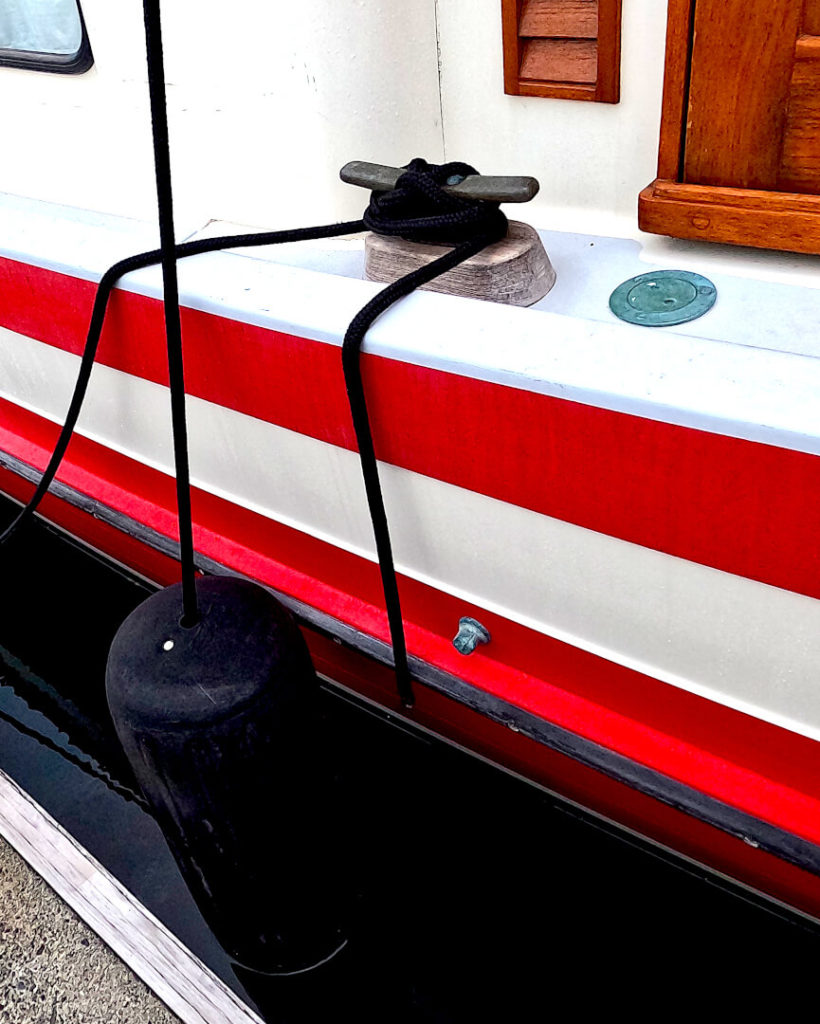
Here are a few things that I would look for in an ideal Nordic Tug 26 for cruising the cool, wet waters of the Pacific Northwest:
- The L-shaped settee that allows children to sleep there without dropping the table each night.
- Our boat did not have a shower. Personally, I don’t want to go more than one night without a nice hot shower. Many marinas offer showers, if your family isn’t shy about that sort of thing and doesn’t mind feeding a handful of quarters with soap in their eyes.
- Our boat came equipped with an annual Washington State Marine Park Permit. This is a huge asset in the San Juan Islands. When you dock or pick up a mooring in the marine parks, you’ll need to pay a day use or an overnight fee. The pass doesn’t just save you money, but hassle: you need exact change for the fees and you’ve gotta dinghy back and forth between the pay station on land and your boat to place the permit without the annual pass.
- The wood stove was not a necessity (we didn’t even need to use it) but it would be very comforting on a cold, damp morning. It’s also less finnicky than forced air diesel heaters, which can be troublesome.
Less Important Features
- Don’t sweat the engine size. There are much better options out there if you have a need for speed. The 100 horsepower engine on this boar was more than sufficient, and we would have been fine traveling a bit slower with an older, smaller engine.
- While our boat was equipped with an inverter to provide 120 volt power for small devices like laptops, we only needed it to power the navigation equipment that was installed on the boat. So we wouldn’t be disappointed on a boat without one.
How Much Does a Nordic Tug 26 Cost to Rent and Where Can I Find One?
If you are willing to make the trek across the border, a Nordic Tug 26 named Lady Bug is available from Desolation Sound Yacht Charters in Comox, BC on Vancouver Island. The boat rents for 5,250-5,850 Canadian dollars for 6 days/nights. That’s about $4k-$4.5k USD for an abbreviated week at the time this was written. Note that like our test boat, you won’t have a shower in the head.
While the NT26 is not a common charter boat, there are some good alternatives available to scratch that tugboat itch.
Alternatives to the Nordic Tug 26
Nordic Tug 32/34
One of the main advantages of the Nordic Tug 26 design is that it is small enough to be trailered. If you are a renter, that’s not a concern. In this case, you might also consider the Nordic Tug 32 or 34. The layout and design is so similar that its hard to tell the 32 apart from the 26 in photos. Everything is just 20% taller, thicker, wider, etc. The one place you’ll really notice the difference is in the head: the larger Nordic Tug 32/34s have a dedicated shower stall. The longer boats will also cruise faster when equipped with enough power and accommodate a larger dinghy with an outboard motor.
Crown Yacht Charters and Anacortes Yacht Charters each have a Nordic Tug 32 in charter service in Anacortes, Washington, near the San Juan Islands. Both examples happen to have bow thrusters to help with docking and are equipped with the very capable Cummins 6BT engine.
Ranger Tug
There are a number of Ranger Tugs built in the last 20 years that are a more modern take on the Nordic Tug 26. They range in size from 23 to 31 feet. Many of these boats have a stern drive or outboard engine, which makes them easier to dock. Some have considerably higher cruising speeds as well. Compared to the Nordic Tug 26, they also have a lot more seating and bedding that’s been integrated into the design to help you get more out of a relatively small boat. Personally, I think they feel more cramped and delicate as a result. Critically, they lack pilothouse doors and some of the romance of the Nordic Tug. Nonetheless, they have become very popular for cruising in the Pacific Northwest.
Here are a few examples available for charter:
- Ranger Tug 26 at Ship Harbor Yacht Charters
- Ranger Tug 27 at Anacortes Yacht Charters
- Ranger Tug 29 at San Juan Sailing
How Much Experience do I Need to Rent a Nordic Tug 26?
Because of its small size, the Nordic Tug 26 is a great way to step up to trawlers if you’ve got experience on, say 18 to 22-foot powerboats. The size is manageable while you get used to dealing with the idiosyncrasies of docking a trawler. If you are comfortable docking v-drive or direct drive ski boats, taking the NT 26 out will be a cakewalk. Chartering in an area where you’ll primarily anchor or using mooring buoys will eliminate the stress of docking.
Final Take on The Nordic Tug 26
While I have a moderate amount of cruising experience, George had never been on a yacht, and on past voyages, Rachel had always been hands off, leaving the work to other friends traveling with us. This two-day adventure on the Nordic Tug 26 turned out to be a very ideal introduction to cruising for my crew that ultimately led to our weeklong charter in the Exuma Cays for Spring Break.
George had a chance to take the wheel, learn how to read charts, and use the electronics package. Rachel got to help with the lines, pick up a mooring, and get comfortable with some rough water. All of this was from the comfort of the warm, dry, quiet pilothouse on a boat that wouldn’t have felt overwhelmed to single-hand if it came to that. The cozy but heavy look and feel of the boat also went a long way toward the rest of the crew feeling comfortable and eager to get on the water again soon.
